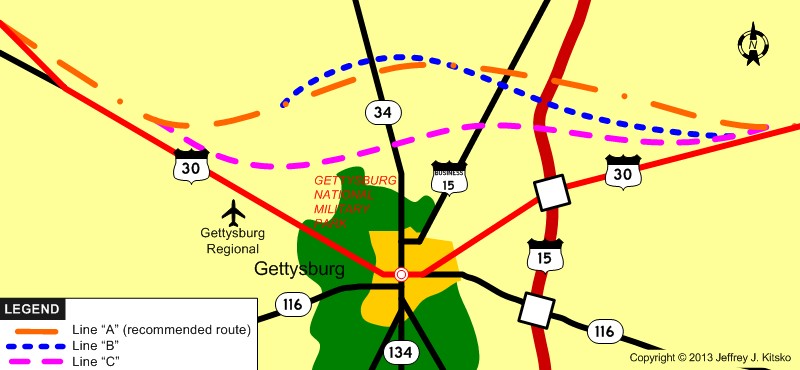The Borough of Gettysburg is perhaps one of the most historic locales in the United States. It is famous for not only the location of Abraham Lincoln's famous "Gettysburg Address," but also one of the bloodiest battles in the Civil War. While a quaint country town during the 19th Century, it became a confluence for north-south and east-west traffic traveling through Adams County in the 20th Century, something that doesn't sync well with the historic atmosphere of the town.
Throughout the 1960s, the idea to remove traffic from the borough began to solidify. The first idea to eliminate through traffic came at a December 6, 1967 Franklin Township Planning Commission meeting, where a northern bypass proposal was discussed but also a suggestion for a "complete belt" around Gettysburg. While the beltway idea was scrapped, a January 9, 1968 meeting at the office of O. D. Ferrari, district highway engineer, was held to discuss widening US 30 from McKnightstown to Gettysburg. Representatives from the Department of Highways, US Parks Service, Adams County, and Senator George Wade were in attendance, who all agreed that the widening project should be abandoned and the funds diverted to the bypass project. Senator Wade suggested definite or alternate alignments be ready for presentation to the State Highways Commission meeting that would be held March 27 in Lancaster. John Callenbach, Adams County planner, and Clifton Rogers, consulting engineer for the county, would make a field survey to determine possible routes. On February 28, 1968, the Adams County Planning Commission adopted the construction of a northern Gettysburg bypass as the number one priority for highway development in the county. The proposed bypass would start at McKnightstown and continue to the US 15 bypass then eastward to the York County line. In order to acquire the necessary funds for construction, the commission requested a transfer of $1.5 million allocated for widening US 30 from McKnightstown to Gettysburg towards the bypass. Callenbach and Senator Wade presented the request to the State Highway Commission which voted in favor of the transfer on March 27.
By the beginning of 1969, the Department of Highways was getting ready to do a feasibility study which is what Clifton Rogers told the Adams County Planning Commission meeting at their January 22 meeting. He said they had aerial pictures and a consultant lined up to begin studying the McKnightstown to US 15 bypass section; however, there was no indication on how soon work would begin but probably within the next year. Three proposed routes were laid out; however, the one that the state favored did not sit well with Callenbach. At a December 17 meeting of the Adams County Planning Commission, he voiced his displeasure with the "in close" alternate that the Department of Highways said would see "2,000 to 3,000" more vehicles a day. He said that there would be considerable opposition for the southerly route of the three and that the additional usage would not outweigh the high price of purchasing valuable properties. Callenbach said he felt that the other two alternatives would be better received and that they were roughly the same in length. Mr. Callenbach had a few allies in his fight against the southern route. On the afternoon of December 29, 1969, the Adams County Soil and Water Conservation District Board joined in objecting to the route because it bisected numerous farms in Seven Stars and Gettysburg.
The first public meeting on the bypass took place on January 27, 1971 at the Gettysburg Junior High School. Department of Transportation engineers and designers took questions from the audience of 150 attendees. Statements from the Gettysburg Borough Council, Cumberland Township supervisors, Adams County Planning Commission, Adams County Soil and Water Conservation District, Department of Forest and Water, Gettysburg Airport, and Department of Health were read into the record, all of which endorsed or found no faults with the "A," or outer, corridor which is the same the Adams County Commissioners approved. The expressway would be roughly 10-miles-long, two-lanes-wide initially, cost $21 million, and open in 1976. There were objectors to even with this corridor, notably property owners who would be affected, but Assistant District Engineer L. M. Robinson calmed their fears by saying that the right-of-way was just a rough approximation. Ten to 15 residences, two to four farm buildings, and three to five commercial structures would be taken by corridor "A" and corridor "B" would cost $23 million and take 10 to 15 residences, five to seven farm buildings, and four to seven commercial structures. Corridor "C" would cost $21.5 million, take 18 to 24 residences, four to seven farm buildings, and six to 10 commercial structures, but PennDOT officials warned that this one would lower the tax base of Cumberland Township due to it cutting through developed areas. The Gettysburg Travel Council submitted a resolution at the meeting that the bypass be "Route 30 to Route 30" rather than stopping at the US 15 bypass as originally planned, and designate the original route through the borough as Business US 30.
 |
Secretary of Transportation Jacob Kassab was warning local officials that there was no money for construction from the state, and the federal government should be approached instead. The bypass wasn't even on the six-year plan for PennDOT, but by December 1972, the Federal Highway Administration had given its blessing to Legislative Route 1070. By the June 27, 1973 meeting of the Adams County Planning Commission, John Callenbach said the new six year plan for road improvements would be due and had high hopes that the bypass would be included. What no one saw coming was the tidal wave of debt that would soon crash down upon the Department of Transportation by 1977 which would grind to a halt all construction of new roadways.
While construction of the bypass was halted, traffic growth in the county had not stopped by the dawn of the 1980s. The man who had seen the plan of a limited-access bypass come and go, John Callenbach, was resigned to the fact that it would more than likely be built as a truck relief route.
The bypass would seem to find new life in the 1990s as a proposal to add four new highways to Adams County and one of the four was the Gettysburg Bypass. Jeffrey Green, an engineer with Orth-Rodgers & Associates, presented the findings of a traffic study to members of two citizens’ advisory committees on April 24, 1991. "We believe such a bypass is essential for three reasons. First, the streets of Gettysburg Borough and Lincoln Square cannot accommodate increased traffic generated by new development along the arteries connecting to Gettysburg. Second, the level of truck traffic in the borough is intolerable today and can only grow worse. And third, much of the traffic increase passing through Gettysburg has neither an origin nor a destination in the borough." Two years later, the tone would change for the worse when transportation officials would announce that a bypass would not be included in a traffic study for the 58-mile-long US 30 corridor through Adams, Franklin, and York counties. PennDOT District 8 Engineer Barry Hoffman announced the preliminary results of a $1.1 million study on January 13, 1993 that was performed by Gannett-Fleming. It showed that Gettysburg is considered a destination point for nearly all traffic utilizing US 30 and very little car and truck traffic was considered "through traffic." Since a bypass would divert only a small amount of traffic out of the borough center, the engineering firm could not recommend construction. On February 18, 1993, State Transportation Secretary Howard Yerusalem announced his support for the first phase of the study but was waiting for the second phase which would look at the need and feasibility of a truck relief route around the borough.
It seemed like a victory to supporters on October 19, 1995, when Gettysburg National Military Park Superintendent John Latschar announced that state transportation officials had reconsidered a US 30 alternate around the borough. The superintendent told the park advisory committee that a deal had been struck with PennDOT District Engineer Barry Hoffman. PennDOT spokesman Grey Penny said his first interpretation is that state officials are not opposed to the idea of an alternate route, but reiterated the findings of the Gannett-Fleming study years earlier. He also cited the seemingly unending issue of funding for PennDOT as another reason for an alternate not being studied. Residents of East Berlin, Biglerville, and Arendtsville objected to an alternate route because they did not want Gettysburg's traffic problems pushed onto them. State Senator Terry Punt asked PennDOT to keep components of a Gettysburg alternate route study in place temporarily so that there would be a viable option if a compromise could be worked out but added, "There is not going to be a bypass because the numbers do not justify it."
 Gettysburg Bypass
Gettysburg Bypass